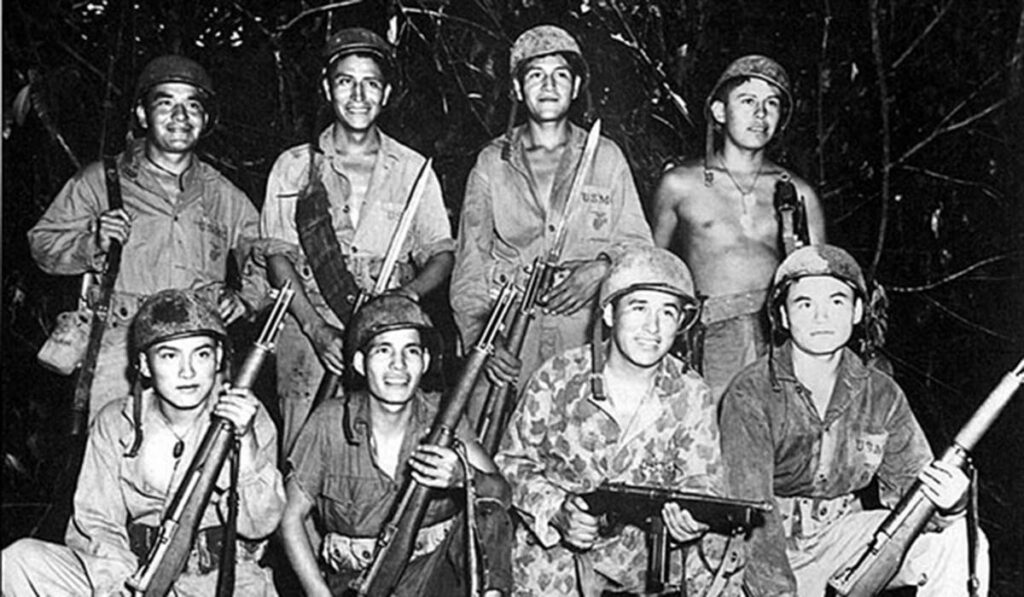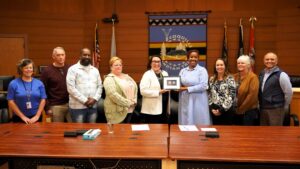![]()
Native Americans have a long, rich history of serving their nation in military service, having participated in every major conflict for more than two centuries. Native Americans today now serve in the United States Armed Forces at five times the national average and at higher rates per capita than any other minority group.
And while Native Americans have a long and unique history of serving in the U.S. military, it is also a proud one. In honor of Native American Heritage Month during the month of November, the Oregon Department of Veterans’ Affairs is offering a brief look at some of the many contributions Native Americans have made to our country through their military service and sacrifice.

From the battlefields of the Revolutionary War to the beaches of Normandy on D-Day to the front lines of today, American Indians and Alaska Native people have defended this country for centuries.
Native Americans had no universal policy during the American Revolution. Some chose to ally themselves with the British to protect their lands, while others served as Minutemen for the colonist rebellion, and others remained neutral. Americans often attributed their victory in the Revolutionary War to the use of tactics and training they learned from their allies in the Catawbas and other Tribes.


Not enough Americans are familiar with Brigadier General Ely Samuel Parker, born Hasanoanda and later known as Donehogawa, a member of the Seneca Nation who served as General Ulysses S. Grant’s military secretary during the Civil War and even wrote the final draft of the Confederate surrender terms at Appomattox.
Parker later said of the Confederate surrender, for which he was present, that southern General Robert E. Lee “stared at me for a moment,” then extended his hand and said, “I am glad to see one real American here.” Parker shook his hand and said, “We are all Americans.” When General Grant was elected president, he appointed Parker as Commissioner of Indian Affairs, the first Native American to hold that post.
Native Americans were even instrumental in the unification of the United States – Gen. Ely S. Parker, a member of the Seneca Nation, served as Gen. Ulysses S. Grant’s military secretary during the Civil War, and Parker would eventually write the final draft of the Confederate terms of surrender.

A year after the fighting ended in the Civil War, Native Americans began serving as enlisted Indian Scouts in the U.S. Army. Several Indian Scouts were awarded the Medal of Honor. In addition to enlisted and hired scouts, some Native Americans served in Regular Army infantry and cavalry regiments in short–lived Indian companies in the 1890s.

In World War I, approximately 15,000 Native American men and woman served in the military and as Army nurses, despite the fact that members of Indian Nations had not even been granted their American citizenship at the time.
Due in large part to their perceived natural abilities and skill at warfare, American Indians received dangerous assignments. Native American soldiers had a far higher casualty rate than that of any other group: 5% of Native Americans died in combat while less than 1% of all other members of the American Expeditionary Force in France died.
Citizenship would be granted to Indian Nations in 1924 with the passing of the Indian Citizenship Act, spurred along in part by the extraordinary courage and selflessness of Native American WWI veterans.


During World War II, the unique contributions of an extraordinary group of Native American service members became the stuff of legend: the Navajo Code Talkers. The Code Talkers took part in every assault the United States Marines conducted in the Pacific Theater of WWII, sending thousands of messages on Japanese troop movements, battlefield tactics and other communications critical to the war’s ultimate outcome.
Their code, based on the then-unwritten Navajo language, was never broken by enemy cryptologists and is credited with helping the U.S. win the war. Originally, 29 Navajo men joined the Marine Corps for this highly sensitive operation but, by the end of the war, there were approximately 400 Native Code Talkers in the military from the Navajo, Cherokee, Choctaw, Lakota, Meskwaki and Comanche tribes.
Samuel Sandoval, one of the last Navajo Code Talkers, passed away earlier this year at the age of 98, leaving only three Navajo Code Talkers remain with us today: Peter MacDonald, John Kinsel Sr. and Thomas H. Begay.

Aside from the code talkers of WWII, many other Native Americans contributed to the war effort. Of the 350,000 American Indians living in the country at the time, nearly 45,000 of them enlisted in the Armed Forces, making them the demographic with the highest rate of voluntary enlistment in the military throughout the entire war. Some Tribal Nations saw as many as 70% of their men enlist in the cause.
Their ranks included Corporal Ira Hayes of the Pima people, who was one of the six Marines who famously erected the American flag on Iwo Jima, helping inspire generations of Americans with their iconic courage and patriotism.

About 29,700 American Indians served in the Korean War, fighting alongside their fellow Americans with honor. Five Native American Korean War service members received the Congressional Medal of Honor, the highest award given to a member of the U.S. military for valor in action against an enemy force.

Among them was Mitchell Red Cloud Jr., a Wisconsin member of Ho-Chunk Nation, who had also served in the Marine Corps in World War II. During a brutal battle in 1950, Corporal Red Cloud singlehandedly held off a surprise attack by Chinese forces, giving his company time to retreat, despite being shot eight times and ordering his men to tie him to a tree so he could continue fighting.
During the Vietnam War, approximately 42,000 Native Americans served in Southeast Asia either as advisors or as combat troops. Despite the unpopularity of the war, Native Americans joined the service at three or four times the rates of their fellow Americans: Approximately one out of four eligible American Indians served in the military forces in Vietnam, compared to one out of 12 in the general population.

American Indian women have also answered the call to serve over the years, first as nurses. An estimated 800 Native American women joined the war effort in the various women’s branches of the military formed during WWII, including WACS, WAVES, Women Marines, SPARs and WASPs. 10,000 more would join the Red Cross.
Today, almost 20% of all Native American service members are women, compared to the approximately 15% of all other service members who are women. In our modern U.S. military today, American Indians and Native Alaskans have carried on a tradition of service and sacrifice. Since September 11, almost 19% of all Native Americans have served in the Armed Forces – in comparison to an average of 14% of all other ethnicities.
Views: 662

